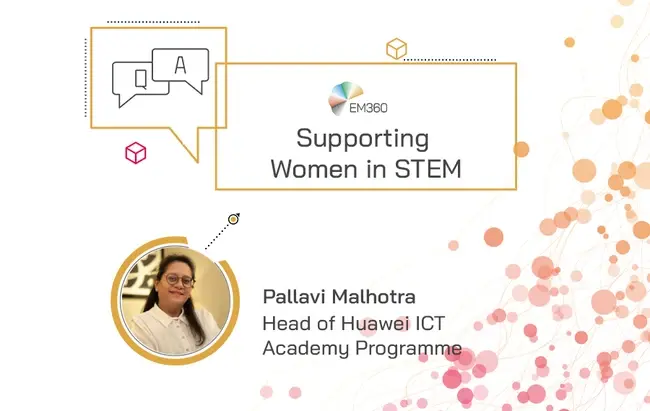
Supporting Women in Stem
Despite the heavy contributions women in STEM have made over the last century, the inflictions of overt sexism, misogyny and unconscious biases have retained a hostile environment for many in the industry. When the problem is embedded into every facet of the industry, we have no option but to recognise it for what it is: institutionalised sexism.
While computer science was originally regarded as “women’s work” and telecommunication being an industry that was pioneered by women, PWC reports that only 16% of the women they surveyed were advised to pursue a career in STEM. We interviewed Pallavi Malhotra; Head of Huawei ICT Academy Programme, Western Europe, to find out what she has learned in her extensive years in the industry.
Pallavi, it’s an honour to be speaking to you about this today. When you first became interested in STEM, what support did you receive?
Looking back, when I became one of the UK’s first female telecoms apprentices, in the mid-1970s, it’s hard to imagine how different the world was. During the 70s, many schools didn’t allow females to take STEM subjects. I was encouraged to take home economics and cookery classes – my father had to argue for me to join STEM classes.
There were no women mentors to guide or support me and I had to work harder than most of my male colleagues. But, I was a determined and hardworking young woman and I wasn’t going to give up just because the tradition was that I should be at home, looking after a family and children.
Have you witnessed much progress be made in regards to gender equality in the industry?
Today, I can see that gender equality and diversity in the ICT industry has improved considerably and there are many companies taking action to improve the situation. But there is still a big issue; a recent World Economic Forum Report (2020) stated that the representation of women in cloud computing was only 12%. In data it was 15% and in AI it was 26%.
Not only is the gender equality and diversity issue big, it’s an urgent issue too. In a post-COVID world with increased levels of digitisation and in which many industries will have been intelligently transformed, the urgency with which more women must be brought into the ICT workforce, to plug the skills gap, is greater than ever.
Where does this problem first start to show its symptoms?
According to the WEF research, the gender gap in technology starts at school and continues into further education and beyond. Likewise, a recent study carried out by PwC on Women in Tech which looked at the experiences of 2,000 A-Level and university students in the UK found that just 16% of females had been suggested a career in tech compared to 33% of males; only 3% of females said that a career in tech was their first choice, and over a quarter of female students said they had been put off from a career in technology because it’s too male dominated.
So, what can we do to fix this problem?
It sounds obvious but encouraging, supporting, and promoting STEM subjects to young women and giving them information about the types of jobs available in technology and what they entail, is really powerful.
Support and encouragement needs to start at home and continue throughout the academic career from teachers, career services and industry.
We also need to have more female technology teachers, mentors and practitioners to speak to girls and women and show them what a job in technology entails and what can be achieved. We need to talk more about our own experiences to young girls.
As well as encouraging girls to take STEM subjects, careers in tech need to be portrayed as attractive, fun and interesting. We need to provide the skills and instil confidence in young women.
Schools and colleges should also offer a variety of technology taster sessions to encourage girls and work closely with industry partners to organise industry visits and presentations by females working in the Digital and IT sector. If girls don’t know the facts, how can they make an informed decision?
It seems like you believe that this problem needs to be treated holistically. How can bigger players in the industry help fight sexism?
Another sector that needs to play a part, is the private sector, especially leading companies that operate within the Digital and IT sector.
That’s why, for the last 5 years I have been working with Huawei, as Head of its ICT Academy Programme across Western Europe, promoting digital skills education for all, empowering women and helping females participate in the digital economy.
Our programme works with Universities, Colleges and Schools enabling students to gain Digital & IT Sector industry certifications and valuable employable skills, and I’m pleased to say that each year we are seeing a gradual increase in the number of female students.
We are also finding new ways to get women interested, for example by piloting ‘women only’ STEM classes. I believe that having a female teacher will encourage more girls to join the course as they feel more comfortable to ask questions and create a network of women that can support each other through their learning journey.
Learning from the difficulties that I have personally experienced, I feel these classes would be of great benefit and that the female teacher will provide a great role model.
We are also working on a Virtual Work Experience Pilot. Alongside some amazing colleagues at South Staffordshire College, we hope to create a great virtual work experience model that will encourage more girls to experience working virtually in a technology company.







Comments ( 0 )